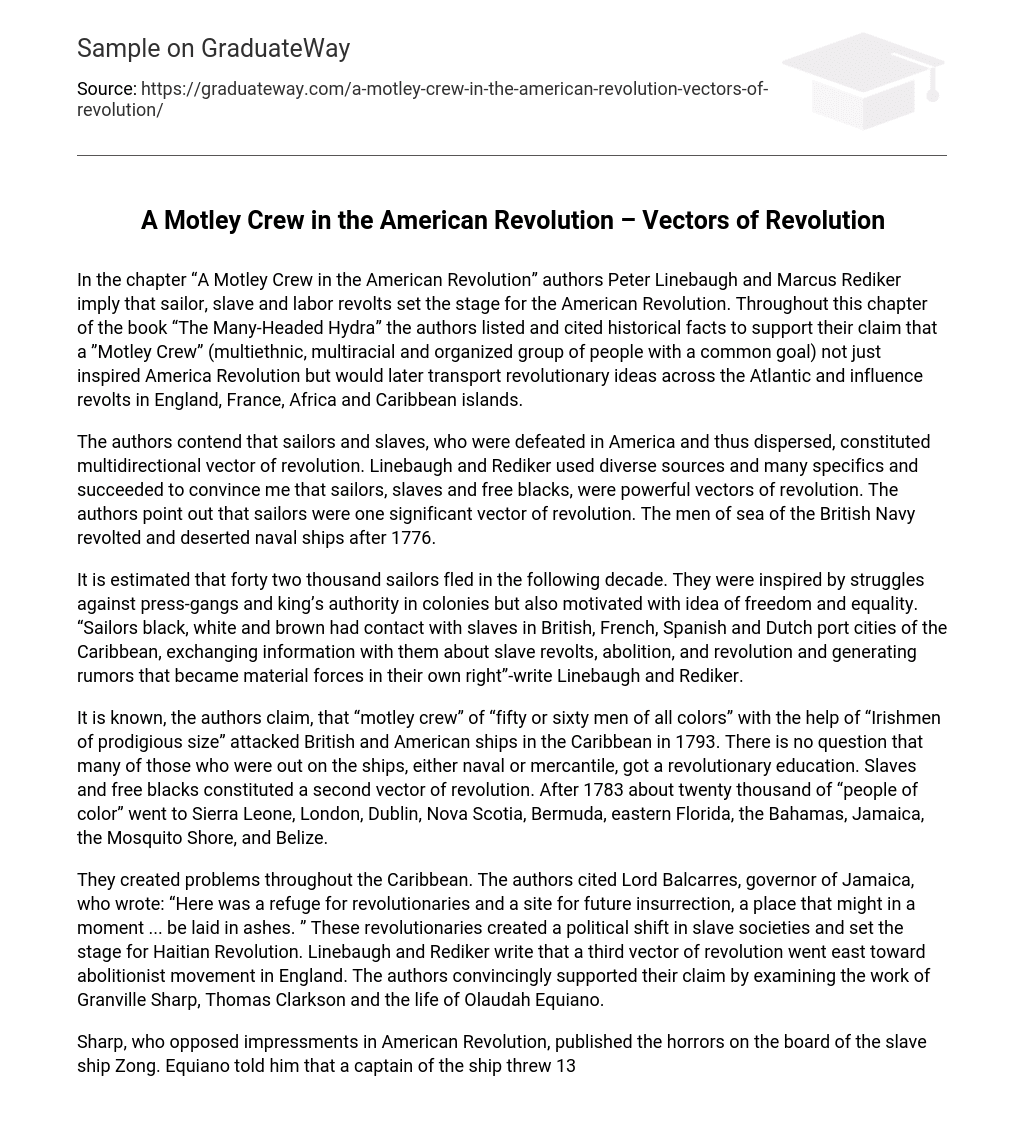In the chapter “A Motley Crew in the American Revolution” authors Peter Linebaugh and Marcus Rediker imply that sailor, slave and labor revolts set the stage for the American Revolution. Throughout this chapter of the book “The Many-Headed Hydra” the authors listed and cited historical facts to support their claim that a ”Motley Crew” (multiethnic, multiracial and organized group of people with a common goal) not just inspired America Revolution but would later transport revolutionary ideas across the Atlantic and influence revolts in England, France, Africa and Caribbean islands.
The authors contend that sailors and slaves, who were defeated in America and thus dispersed, constituted multidirectional vector of revolution. Linebaugh and Rediker used diverse sources and many specifics and succeeded to convince me that sailors, slaves and free blacks, were powerful vectors of revolution. The authors point out that sailors were one significant vector of revolution. The men of sea of the British Navy revolted and deserted naval ships after 1776.
It is estimated that forty two thousand sailors fled in the following decade. They were inspired by struggles against press-gangs and king’s authority in colonies but also motivated with idea of freedom and equality. “Sailors black, white and brown had contact with slaves in British, French, Spanish and Dutch port cities of the Caribbean, exchanging information with them about slave revolts, abolition, and revolution and generating rumors that became material forces in their own right”-write Linebaugh and Rediker.
It is known, the authors claim, that “motley crew” of “fifty or sixty men of all colors” with the help of “Irishmen of prodigious size” attacked British and American ships in the Caribbean in 1793. There is no question that many of those who were out on the ships, either naval or mercantile, got a revolutionary education. Slaves and free blacks constituted a second vector of revolution. After 1783 about twenty thousand of “people of color” went to Sierra Leone, London, Dublin, Nova Scotia, Bermuda, eastern Florida, the Bahamas, Jamaica, the Mosquito Shore, and Belize.
They created problems throughout the Caribbean. The authors cited Lord Balcarres, governor of Jamaica, who wrote: “Here was a refuge for revolutionaries and a site for future insurrection, a place that might in a moment … be laid in ashes. ” These revolutionaries created a political shift in slave societies and set the stage for Haitian Revolution. Linebaugh and Rediker write that a third vector of revolution went east toward abolitionist movement in England. The authors convincingly supported their claim by examining the work of Granville Sharp, Thomas Clarkson and the life of Olaudah Equiano.
Sharp, who opposed impressments in American Revolution, published the horrors on the board of the slave ship Zong. Equiano told him that a captain of the ship threw 132 slaves overboard to preserve supplies and later tried to collect insurance money for the dead. Sharp also worked on founding a free state of Sierra Leone in 1786, and served on the Committee for Effecting the Abolition of Slave Trade. Clarkson collected evidence about slave trade through informants (sailors and former slaves) in ports of Liverpool, Bristol and London.
But the connection of sailors to the abolitionist movement, the authors write, was best articulated through the life of Olaudah Equiano. Enslaved in West Africa, he was a witness of horrifying events constantly happening on board of the ships. He was sold and resold, participated in demonstrations and worked on sugar plantations in West Indies. He knew that “terror was the fate of both sailors and slaves”. Equiano had learned to read and write and later wrote his own verses of enslavement and imprisonment.
Fourth vector of revolution pointed toward Africa. African Americans with the help of the people like Sharp and Equiano settled in Sierra Leone after 1783. The authors contend that the movement eastward across the Atlantic on one hand was similar to that of radicals after English Revolution, in terms that both actions challenged slavery and had been defeated. On the other hand, the later movement was a seed for the eighteen century revival of antislavery ideas and consequently converted defeat into a victory.





